Impact of Coexistence of Microplastics and Biochar on the Abundance and Structure of Soil Fungal Communities
IF 0.5
4区 医学
引用次数: 0
Abstract
In this pursuit, we analyzed the effects of microplastics (PP, PE, PVC) and microplastics and biochar coexistence (PPR, PER, PVCR) on soil fungal community structure and diversity, and functional prediction analysis. Results showed that microplastics and their coexistence with biochar had a significant impact on the soil physicochemical, with PVCR treatment exhibiting the highest soil pH, organic carbon, phosphorus, potassium, and ammonium nitrogen content. Microplastics and their coexistence with biochar significantly increased fungal abundance, with PPR treatment having the highest fungal abundance. Microplastics and their coexistence with biochar (except for PP) significantly reduced the soil fungal diversity indices. The dominant fungal communities were Ascomycota, Basidiomycota, and Zygomycota, while at the genus level, Mortierella, Aspergillus, and Fusarium were found to be dominant taxa. Microplastics and their coexistence with biochar promoted the Basidiomycota and Mortierella and inhibited the Ascomycota and Fusarium. Effect of microplastics and biochar coexistence was significantly higher than that of microplastics alone. Soil pH, ammonium nitrogen, organic carbon, nitrate nitrogen, and potassium were main factors affecting the soil fungal community structure changes. FUNGuild functional prediction results showed that microplastics and their coexistence with biochar had a significant influence on the functional group. The relative abundance of pathogenic-saprotrophic-symbiotic nutritional fungi was the highest in the PPR while the PVCR showed the highest relative abundance of saprotrophic nutritional fungi. In summary, the coexistence of microplastics and biochar had a significant affect the soil fungal community, while its impact exhibited variations depending on the type of microplastics.微塑料与生物炭共存对土壤真菌群落丰度和结构的影响
为此,我们分析了微塑料(PP、PE、PVC)和微塑料与生物炭共存(PPR、PER、PVCR)对土壤真菌群落结构和多样性的影响,并进行了功能预测分析。结果表明,微塑料及其与生物炭共存对土壤理化性质有显著影响,其中PVCR处理土壤pH、有机碳、磷、钾和铵态氮含量最高。微塑料及其与生物炭的共存显著提高了真菌丰度,其中PPR处理真菌丰度最高。微塑料及其与生物炭的共存显著降低了土壤真菌多样性指数(PP除外)。优势真菌群落为子囊菌门、担子菌门和合菌门,属水平上优势真菌类群为Mortierella、Aspergillus和Fusarium。微塑料及其与生物炭的共存促进担子菌群和摩氏菌群的生长,抑制子囊菌群和镰刀菌群的生长。微塑料与生物炭共存的影响显著高于微塑料单独存在的影响。土壤pH、铵态氮、有机碳、硝态氮和钾是影响土壤真菌群落结构变化的主要因素。FUNGuild功能预测结果表明,微塑料及其与生物炭共存对其官能团有显著影响。致病性-腐坏性-共生性营养真菌的相对丰度在PPR中最高,而PVCR中腐坏性营养真菌的相对丰度最高。综上所述,微塑料与生物炭共存对土壤真菌群落有显著影响,但其影响因微塑料类型而异。
本文章由计算机程序翻译,如有差异,请以英文原文为准。
求助全文
约1分钟内获得全文
求助全文

 求助内容:
求助内容: 应助结果提醒方式:
应助结果提醒方式:


